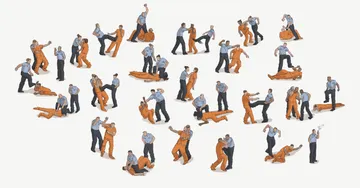This is The Marshall Project’s Closing Argument newsletter, a weekly deep dive into a key criminal justice issue. Want this delivered to your inbox? Subscribe to future newsletters here
From endemic violence and inescapable heat, to demeaning labor conditions and inedible food, many jails and prisons across the U.S. exist in a state of near-permanent crisis and inhumanity. We’ve touched on many of these conditions in past editions of this newsletter, and in other recent work from The Marshall Project.
Earlier this month, I had the opportunity to discuss some of these issues during a symposium at the University of Texas at Austin Law School. The session focused on four of the most troubled carceral systems in the country: Rikers Island jail in New York City, and state prisons in Alabama, Arizona and Texas.
The event’s organizers brought together experienced journalists alongside formerly incarcerated people, prison administrators, and civil rights lawyers. For this edition, I wanted to share key takeaways from our discussion about each system, and some of the most recent work from the journalists who participated.
Rikers Island
Low staffing levels and lax oversight are often cited as important reasons for deadly conditions behind bars, but despite one of the highest staff-to-prisoner ratios, and being subject to several levels of oversight, Rikers is one of the most dysfunctional lockups in the country.
Reuven Blau, co-author of the recently published book, “Rikers: An Oral History,” said the dramatic upswing in corrections officers calling out sick — about a third of the staff starting in 2021 — has worsened conditions there. Last week, Blau reported that investigators are examining an apparent time card scam some officers were allegedly using to get paid when they weren’t on the job.
Sarena Townsend, the former disciplinary manager and deputy commissioner at the New York Department of Corrections, said watchdog groups that once had 24-7 remote access to surveillance cameras inside the jail complex have recently lost that access. She said moves like this from the Department of Corrections, which limit transparency, have been commonplace.
Alabama
I spoke with Ronald McKeithen, an artist, advocate, and writer who spent 37 years in Alabama prisons for an armed robbery, after being sentenced under the Habitual Felony Offender Act. McKeithen discussed how “prison has become a mental institution and a nursing home” because of long sentences and stingy parole practices, “You see guys' hope evaporate,” he lamented, “and they just fade away.”
The U.S. Department of Justice has said that conditions in Alabama prisons are unconstitutional. Late last year, some people incarcerated there launched a labor strike to protest their poor treatment.
McKeithen now works in re-entry, helping people recently released adapt to life on the outside. He spoke powerfully about what it was like to return to freedom after many years — how even seeing people smile at him was disorienting for months. “It's hard, coming from a dungeon, to walk into the sunlight.”
For more of his story, I highly recommend Beth Shelburne’s 2020 reporting in the Daily Beast. She points out that Alabama’s “habitual offender law has condemned hundreds of people who never physically hurt anyone to grow old and die behind bars.”
Arizona
This summer in Arizona, a federal judge ruled that healthcare and confinement conditions in state prisons were unconstitutional and “plainly grossly inadequate.”
Many blame the 2012 privatization of the prison health system for the bad conditions. Corene Kendrick, deputy director of the American Civil Liberties Union’s National Prison Project, noted that Arizona had cycled through four private healthcare providers in recent years with no apparent improvement in care. She said that while state-run healthcare systems are not perfect, at the very least, corrections officials have control when things are run in-house. When it’s a private contractor, officials “can't tell them what to do,” she said.
If contractors don’t listen, corrections officials have little recourse, Kendrick noted, as it’s difficult to cancel contracts that run for years and are worth millions of dollars.
Arizona Republic journalist Jimmy Jenkins, who also joined the conversation, has been covering these issues for years and reported on some recent updates to the legal case.
Texas
Prisons without air conditioning regularly reach temperatures of 110 degrees in Texas, and lawsuits have forced the state to move “heat sensitive” people to cooled units. Speaking with Scott Medlock, one of the lawyers who brought the case, my former colleague Keri Blakinger pointed out how lawsuits can also have unexpectedly negative consequences, because of how prisons respond.
“No matter what sorts of good changes you force prisons to make, they consistently find a way to also do some really shitty stuff with that,” Blakinger said.
She said she often gets letters from prisoners who are moved to get them away from the heat, but then lose access to better services. “They’d get moved from a prison where they could get out and have a job and education and do things, to a higher security prison where the only cooled cells are solitary,” she said.
We published a primer on prison heat this summer, and you can also hear Keri speak more about the issue on Democracy Now.
